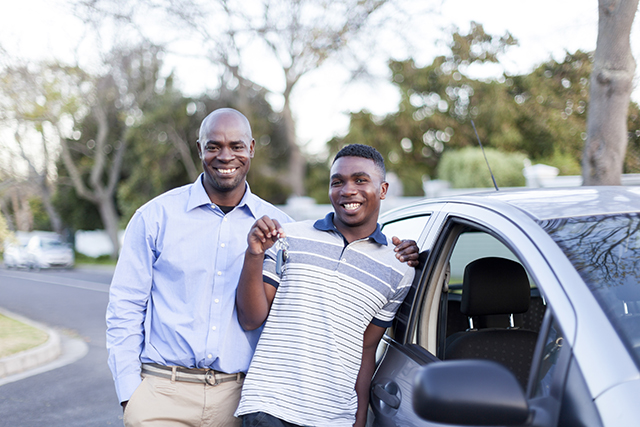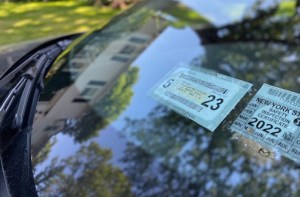It’s an exciting day when your child finally gets a driver’s license, but shortly after you’re faced with a big decision. How do you pick a good first car? What makes for an ideal – and safe – starter vehicle?
If you haven’t bought a car recently it may be overwhelming to look at all the options. We break down the basics to make finding the best first car for your young driver a snap.
Focus on safety
Safety is a top priority. The challenge is figuring out which cars are the safest for teens. According to the AAA Foundation for Traffic Safety, teenagers are three times as likely as adults to get into a deadly crash while driving.
A good place to start your research is the National Highway Traffic Safety Administration or the Insurance Institute for Highway Safety, where you can view crash test ratings, learn about advanced safety features and more.
AAA also provides teen driver resources at TeenDriving.AAA.com.
There are lots of new autonomous safety features found on today’s cars, but they often add quite a bit to the price. Focus on crash test scores first and then see what your budget allows.
Size matters
There are cars with room for anywhere from two people all the way up to a small army of teenagers. Think like Goldilocks and avoid those two extremes. Instead, go for the just-right option in the middle – you want plenty of protection in case of a fender bender.
Say no to performance
There isn’t a teenager out there who hasn’t dreamed of having a shiny red sports car in their driveway on the day they turn 16. High-horsepower sports cars are fun but aren’t a good idea for those who are still learning to drive. Let your kids keep dreaming about that fancy sports car and buy them something they can easily handle instead.

Think long term
Although you may be buying your child’s first car in high school, there’s a good chance it won’t be replaced until after college. It’s important to get a car that will last through all those years.
Consider a car with extra room for hauling stuff back and forth to college and apartments. Hatchbacks are great at doing double duty, with plenty of seating for passengers and a versatile cargo area.
Go with good fuel economy
Even if they have a job, young drivers don’t typically have tons of extra cash. If it’s too expensive to fuel up their new car, there’s a good chance they’ll be coming to you for a little help to fill the tank. Make it easier for them and buy a car with good fuel economy.
This also figures into the long-term value of a first car. Your child will likely go from broke high schooler to broke college student, so every penny matters. Buying a first car with good fuel economy ensures they’ll be able to keep if fueled up and ready to go throughout their college years.
Don’t forget technology
Technology is everywhere, including your car. This is generally a good thing, but it’s also a major cause of distracted driving. As a parent, how do you make sure your child is using in-car technology safely?
Features like Apple CarPlay and Android Auto seamlessly integrate smartphones with in-dash systems and reduce the temptation to pick up the phone, but have also proved to be distracting.
Automakers are helping by adding teen driver systems that keep the radio’s noise level down, encourage seatbelt fastening and more. The systems also provide parenting-assistance options, so you can coach them toward better driving habits. Learn more about teen driver technologies.
Follow these simple guidelines and you’ll easily find a first car for your new driver that he or she will never forget. Do you remember you first car?
If buying used, make sure to get a thorough inspection
A used car can be a great option for your kid as these vehicles generally cost less but usually still have many of the latest safety and technological features available. That said, since these cars have been around the block a few times, it’s important to get a used car thoroughly inspected and test driven before purchasing. Here are the items to look for:
- Remove all four wheels and check all the brakes including the parking brake.
- Fully inspect the steering and suspension system.
- Look for signs of rust or previous body repairs. Is the interior badly worn or does it look too pristine, like something was replaced to cover a long history or possible abuse? This all needs to be performed with the vehicle on a lift to carefully look for problems.
- Check the computer for diagnostic fault codes and be leery if the computer memory was cleared recently—someone could be hiding a check engine light issue.
- Drive the car. How does it ride? How does it handle? Does it drive straight?
- How does the engine perform and how does the transmission shift?
- Look for any smoke coming from the tailpipe (blue and white are bad).
- Operate all the controls. Does the A/C and heat work? Do the windows? Some window repairs can be $500 and up.
- Check all the vital fluids (much can be learned from fluid color), belts and hoses.
- Ask if there are maintenance records. Reports from the likes of CARFAX or AutoCheck can’t hurt but doesn’t always tell the entire story.
- Finally, use all of your senses, look over everything carefully, look around in nooks and crannies, check the trunk or spare tire storage for signs of water (could have been in a flood). Does it smell mildewy or too sanitized?
It’s always best to have a thorough inspection of a used car done by a professional auto shop, such as one of AAA’s Approved Auto Repair facility. Click here to find one closest to you.
Find tips for parent-teen driving agreements and other teen driver resources at TeenDriving.AAA.com.
Next step: car insurance. Click here for a complete guide to teen auto insurance. Then visit AAA.com/Insurance to see all the options available for your teen driver.
5 Thoughts on “Tips for Choosing Your Kid’s First Car”
Leave A Comment
Comments are subject to moderation and may or may not be published at the editor’s discretion. Only comments that are relevant to the article and add value to the Your AAA community will be considered. Comments may be edited for clarity and length.















I have 3 boys and have been there, done that. Here is my input for buying a used car.
1) always bring it to your mechanic or find a mechanic in that area and have them do a full inspection. Well worth the $120.00 or so you will pay for this service. Could save you thousands in the long run.
2) the carfax only shows reported accidents. It could have had the front end replaced and it will only show up on the report if it was reported to the insurance company. I always check on the front end and look for parts that don’t fit the age or mileage. Like grills that look to clean. A bolt or screw that looks new. Fresh paint job. Something that just doesn’t look right. I would never buy a car with front end damage or had front end damage.
3) Look under the car for rust.
3) my mechanic highly suggests a toyota. (toyota corolla) They have strong engines and will go over 200,000 miles or more. Next would be a Honda.
4) check the internet for recalls and consumer reviews. I found certain cars that have problems at high miles.
5) try to get some type of warranty. Most will give you 30 days or 1250 miles. It is something !
6) I always call a major dealership for that model and brand. Ask the service guy about problems with the car you might buy. See if they know of any problems with that model and year.
7) always make an offer. Even if they tell you there is no room. The negotiation always starts when you get out of the chair to leave and tell them you don’t like the deal.
Good Luck !!
Those are very good pointers, Pete. Thanks!
This article is great and very informative for parents!!
Great information!
For the vast majority of your readers, the question is not which car should I buy for my new teenaged driver but which of the cars I already own will I allow my teenager to drive.
You’re absolutely right, Greg. I’m with you on that one. Most parents can’t afford to buy or lease new cars for their kids. They are already paying hefty interest to pay off their houses (if they can afford one at all) so why add to their burden by paying extra for cars. Also, let’s not forget that kids need car insurance as well and the rates for teenagers are ridiculous these days.
It seems the only affordable way is let them drive your cars or buy used one and add it to your policy. It’s risky but for many parents it is the only option.